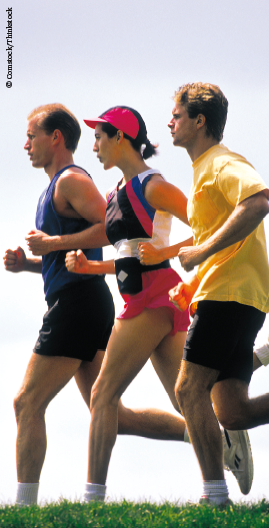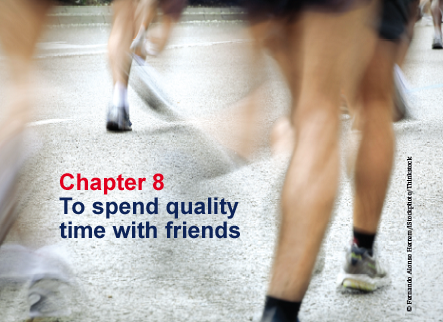

| 65 | I enjoy the social time with my running group |
Thousands of runners have told me that they would only run about half of their current running days per year it weren’t for the motivation boost they get from their running group.
Because the group is there even once a week, it’s easier to get out of bed early. You feel the energy of the group members as you contemplate rolling over in bed. You know that if you don’t join them, you will have to answer their emails or explain your laziness in person when you see them. As you get ready, you will feel the group support and look forward to it.
If the afternoon is the best time for you to run, try to find an after-work running group. Because the group is waiting, one tends to run in the afternoons even after a long and stressful day. There’s an obligation to get together and, once running, a chemistry that erases the end-of-the-day fatigue.
Because of the group, there’s more support to finish the tough workouts. When in the right group, the power of the community is greater than the sum of the individuals. While running with one or more teammates, unexpected strength emerges to push through adversity. An additional wave of positive energy is bestowed as you give support to others who need it.
Because of the group, I have the best friendships. The bonding that occurs in running groups is personal, honest, and empowering. Life-long friendships have been made in practically every running group with which I’ve been associated.
Most group members feel supported even on the solo runs between group runs. During the week, when running on my own, I don’t want to let my group down by getting out of shape. As I struggle to get out of bed or out the door after work, I think of the other group members overcoming their motivation issues and running. I feel empowered through this connection.
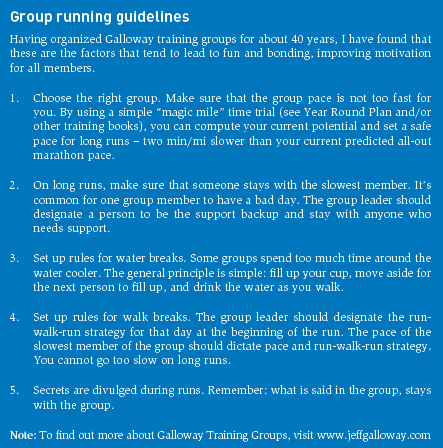
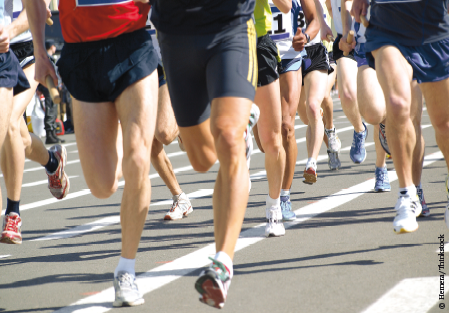
| 66 | Running helps to “talk things out” |
When runners talk during a run, they tend to be more honest and guttural. Some of my most interesting and open conversations have occurred during a run. This is probably due to some hardwired instincts going back millions of years.
Trust during long treks. According to anthropologists who study ancient man, our ancient ancestors first developed the “human” social behavior patterns when they migrated together during Paleolithic times. Those who cooperated had a better chance of survival by supporting one another.
When we run, the “human brain” is activated. This is the center for conscious thought, where language and speech are controlled. It’s very common to see a normally shy person change into a talker during a run with friends. There is a sense of intuitive trust that allows running group members to speak honestly.
Parents who run with their kids often discover information and feelings they would never find in other family experiences. Friends can reconnect during a run and bring each other up to date after two decades often during one run.
When there is a tough issue between individuals, a walk or run can promote relaxation, a lowering of anxiety, and honest communication.
So there are often statements made in confidence during a run. Remember the runner’s rule of trust: what is said on a run, stays on the run.
| 67 | Challenge a friend to a race |
A significant number of the new runners today got off the couch because they responded to a challenge. One friend challenges a friend to complete an event such as the Epcot Wine & Dine Half Marathon at Disney World. In many cases, one or both have not been doing any training. Both friends find that they have more fun as they get to know one another better.
One + one = motivation. Even when living in different cities, the connection through training can enrich a relationship while giving each person a motivation boost. There’s a special personal chemistry that occurs when one person wants to help another get in better shape.
Meaningful connection. The novice wants to realize the expectations of the mentor and usually asks one question after another. The mentor realizes the need to offer good advice and will read books such as Galloway’s Marathon FAQs or Half Marathon. The books have actually been great ways to fill the information gaps and proceed in a coordinated way.
Reward Race weekend. The planning for race weekend offers another bonding experience: registering for the race, travel, hotel, sightseeing in the area, etc. The first longer race experience is a big deal and should be savored as much as possible.
Empowering accomplishment: In almost every case, the challenges are met and the weekend is a very memorable event. But the power of the experience was in the communication among friends for months leading up to the race day. This will be remembered by both runners for the rest of their lives.
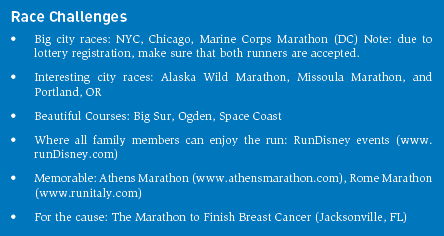
| 68 | The special bond that occurs during a run |
I meet a lot of people during the year, and I try to recognize something to respect in each one. Try as I might, I don’t usually have the memory to pull up all of this when I see the person again at another clinic, expo, or consultation at my Phidippides store in Atlanta.
But when another runner reminds me of a certain run, something about the course, the weather, or the events of the day, I usually remember not only the run, but I feel a sense of the personalities of the other runners on that run.
There is a special chemistry that brings two or more people together during a run. Many have described this as “psychic energy” that is transmitted and received in areas of the brain that we don’t use as much as we did in ancient times.
Some anthropologists believe that the human traits of cooperation, teamwork, caring, and supporting one another were developed during a million-year period. Our Paleolithic ancestors went from being fiercely individualistic to begrudging companions for protection. With the evolution of tribes, our ancestors learned to rely upon one another and, at some point, care for and respect one another.
We are molded by our behaviors. Our Paleolithic relatives were moving constantly every day in the search of food and shelter. Forward motion exercise (walking/running) literally brought our ancient ancestors together. Gradually, they developed the intuitive communication that we have inherited and enjoy during a run.
The best communication occurs when stress is low. Running and walking at a gentle pace trigger a release of the stress of life and positive attitude hormones.
We will tend to be more upbeat and open to talking and sharing when the pace is gentle and easy. As the effort level rises, so does the stress level. At a certain stress level, the exercise is too hard and communication stops.
Sometimes running at a fast pace will result in bonding of a different type. When runners are trying to achieve a time goal that is challenging, speed training becomes very important. Having one or more partners to pull you along will usually result in fewer workout dropouts, better quality, and better performances at the end. Going thought a training season together brings people together.
When you share a run with a stranger, be prepared to have a new friend by the time you have finished.
| 69 | Run with a friend or spouse who is slower |
Running more slowly, even several minutes per mile slower than you usually run on an easy day, will not result in a loss of fitness. This allows you to share special time with a spouse, a new runner, or an old running friend who is returning to running after some time off.
Running slower may help you. If you have a tendency to run too fast on easy days or are not slowing down enough on long runs, your slower running buddy can allow you to recover from your long or faster workouts and avoid overuse injuries.
If you’re having trouble slowing down, take walk breaks more frequently. Many men tell me that they cannot run slow enough to run with their wives. This can be true when running continuously. By using frequent walk breaks, most couples can find a ratio that works. For example, if it’s hard to slow down to 10 min/mile by running for 3 minutes/walking for one minute, then try 2/1 or 60 seconds running/30 seconds walking. Some couples can run 10 to 11 min/mi by running 1/1.
The slower runner can use the run as a speed workout. In this case, the faster runner won’t have to slow down as much, but the faster runner needs to monitor pace and ensure that this is not excessive for the running buddy.
So run with a buddy on one of your slow days and help him or her improve speed.
| 70 | Run with a friend who is faster |
If you run slowly all the time, you probably won’t run any faster. But by running with a faster friend, you can pick up your pace without doing injury-risking speedwork.
Talk with a friend who will help you. You want someone who can gently pace you slightly faster than you have been currently running. Some runners don’t have a good sense of pace and will run much too fast. You will either need to have a GPS device to measure pace or run on a marked and measured course.
Discuss pace in detail. You should run the first 5 minutes as a slow warm-up. Then run 5 minutes at your normal easy running pace. Pick it up for the next 5 minutes to the pace you would run on a fast day. Then talk with your friend about how you want to run the rest of the workout. In general, it’s best to run 5-10 minutes at your target faster pace and then slow down for 3-5 minutes at a slower pace to recover.
Discuss walk break frequency. It may surprise you, but walk breaks usually allow runners to run faster than when running continuously. You can use the run-walk-run guidelines on page 50.
During the workout, if the pace is just too fast for you on that day, tell your friend. It helps no one to push beyond current limits.
Rest the day before this workout. You want to come into the run with fresh legs. Have fun!
| 71 | A long-running friendship |
The best friendships that I have, that have lasted over the longest period, were forged by running. I stay in touch with some of the original group of kids (at the time) I tried to stay with over 50 years ago on my first runs at Westminster Schools. When I share a series of runs with someone, I almost always like them and treasure the association of new friendship. That’s how things started when I met Geoff Hollister.
Geoff and I literally ran into one another in Newport, RI, in 1966. We were attending Officer Candidate School for the US Navy. At the end of the week was a relay. There weren’t many of the OC’s who ran competitively so during the first two weeks, I had no competition passing runners and winning the race. The third race was different.
It was not unusual to receive the handoff with other runners and behind others. I grabbed the relay baton and quickly passed the runners around and ahead, except for one. During the second half of the race, I tried to move ahead and could not. He and I exchanged the lead several times and neither of us can remember who won.
We were instant friends. We had similar backgrounds, were liberal arts students, and liked to compete. But as we sent letters back and forth, we shared a passion for the joy of running and a growing sense that there was a culture developing around running. Wesleyan was within driving distance of the New England road racing circuit. My cross country teammates were Amby Burfoot (later, Boston marathon champion in 1968) and Bill Rodgers (later, 4-time winner of the Boston and New York marathons). Geoff was very much involved in the exciting track culture and jogging boom, which was developing in Eugene, OR, inspired by Geoff’s mentor Bill Bowerman.
Geoff invited me to Eugene before I left for Vietnam in 1967. I spent 5 days running with him and his teammates on trails, the Oregon coast, and listening to Bowerman’s wisdom.
Bill was in charge of the track/cross country program at the University of Oregon, but he had created an energized running community in his hometown of Eugene by producing some of the nation’s top runners, particularly in the middle and long distances. Bowerman had observed a recreational jogging boom on a trip to New Zealand and had initiated adult beginning running classes out of the U of O campus. His book, Jogging, sold over a million copies in the mid 1960s.
Geoff told me about leading jogging groups (which used walk breaks) and the many innovative Bowerman projects: shoe design, faster tracks that reduced injuries, and a tiny new American sports shoe company called Blue Ribbon Sports (later, Nike). During a visit to Eugene, I helped Geoff open a BRS store in Eugene. This experience inspired me to open my store, Phidippides, in 1973 with Geoff’s help as advisor and mentor.
A “walk on” 800 meter runner for the Ducks, Phil Knight, got an MBA in the early ’60s and talked Bowerman into being his partner in Blue Ribbon Sports. Geoff signed on from the beginning, was listed as the #3 employee, and did lots of odd jobs including selling shoes out of the trunk of his car. I started doing the same in the Atlanta area and out of my dorm room in Connecticut.
Geoff graduated in 1968 and was assigned to the same type of ship in the same Vietnam area of operation. We had runs together to relieve the stress of not being able to run when at sea and other military issues. I returned from my three years of active duty and kept him informed about the excitement that was building in the South with my new team, the Florida Track Club.
Geoff returned from the Navy in 1971 just as BRS changed its name to Nike. He was expanding the company’s presence in promotions while managing a company store in Eugene. He became a mentor to Steve Prefontaine. Pre told me on several occasions how Geoff taught him about business and life.
Many innovations and projects have been inspired or nurtured by Geoff. We have continued to work on various projects. He was involved in the movie Prefontaine and has produced several documentaries.
To this day, Geoff is my dearest friend, and we are in regular touch. During the past few years, he has battled cancer. The worst effect has been the loss of his running. He is constantly working on new projects and pursuing his other loves: wife Wendy, classic cars, sailing, and producing documentaries.
On July 12 of this year, Geoff’s PET scan showed that the treatment was working and he was not threatened by the cancer. This was the best birthday present I have received.
| 72 | Racing my friend/rival in a virtual race |
There’s nothing more motivating for some runners than challenging another runner to a race. Unfortunately, due to schedules, career, family, and other demands, the two “rivals” may not be able to get together in the same place at the same time.
Technology now allows runners to race one another when they live hundreds or thousands of miles apart. Various platforms (most commonly GPS) can track speed and distance and compare progress with others.
Because there is a date on the calendar and an opponent, runners tend to get in more of their scheduled training runs. On days when they tend to slack off, they imagine that their competitor is getting in a good workout. This tends to get lazy runners out the door.
Developing a strategy keeps one focused and under the control of the frontal lobe — as does analyzing the strengths and weaknesses of the opponent. This gives one more control over positive attitude hormones and can reduce the production of negative ones.
Comparing notes, arranging competition, setting up the ground rules all serve to bring the two runners together. Even before the big day, the bonding occurs.
Runners who have shied away from competitive experiences have embraced virtual racing. It offers fun on several levels.
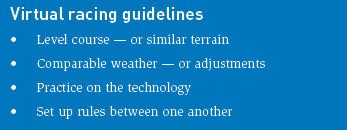
| 73 | To be with my friends – my training group |
I get to run with dozens of different groups during my trips to Galloway Training Program kickoffs and Phidippides fun runs in Atlanta. Each time, a unique and powerful sense of bonding develops when we run together. Even when little or nothing has been said, the experience of sharing the challenge, feeling the exertion, finishing, and comparing notes brings runners closer.
You don’t want to disappoint a friend by not showing up. Thousands of runners have told me that if they didn’t have the scheduled run with their group, they wouldn’t run half as much.
We weave our lives constantly with plots and sub-plots. During a run, the important and fun aspects emerge. A doctor, scientist, or teacher becomes a fellow runner and a real human being. The sharing of common experiences and problems brings us together. Runners support one another.
What is said on a run, stays on the run. Runners share aspects of their lives with fellow runners because of the trust.
My wife Barbara and I run together whenever we can. Currently, we run a marathon a month, side by side. Running brought us together and is a continuing strong thread in our relationship.
